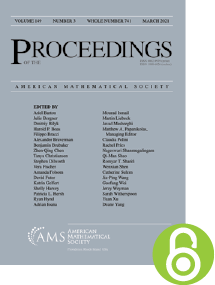Cohesive avoidance and strong reductions
HTML articles powered by AMS MathViewer
- by Damir D. Dzhafarov PDF
- Proc. Amer. Math. Soc. 143 (2015), 869-876 Request permission
Abstract:
An open question in reverse mathematics is whether the cohesive principle, $\mathsf {COH}$, is implied by the stable form of Ramsey’s theorem for pairs, $\mathsf {SRT}^2_2$, in $\omega$-models of $\mathsf {RCA}_0$. One typical way of establishing this implication would be to show that for every sequence $\vec {R}$ of subsets of $\omega$, there is a set $A$ that is $\Delta ^0_2$ in $\vec {R}$ such that every infinite subset of $A$ or $\overline {A}$ computes an $\vec {R}$-cohesive set. In this article, this is shown to be false, even under far less stringent assumptions: for all natural numbers $n \geq 2$ and $m < 2^n$, there is a sequence $\vec {R} = \langle {R_0,\ldots ,R_{n-1}}\rangle$ of subsets of $\omega$ such that for any partition $A_0,\ldots ,A_{m-1}$ of $\omega$ hyperarithmetical in $\vec {R}$, there is an infinite subset of some $A_j$ that computes no set cohesive for $\vec {R}$. This complements a number of previous results in computability theory on the computational feebleness of infinite sets of numbers with prescribed combinatorial properties. The proof is a forcing argument using an adaptation of the method of Seetapun showing that every finite coloring of pairs of integers has an infinite homogeneous set not computing a given non-computable set.References
- Peter A. Cholak, Carl G. Jockusch, and Theodore A. Slaman, On the strength of Ramsey’s theorem for pairs, J. Symbolic Logic 66 (2001), no. 1, 1–55. MR 1825173, DOI 10.2307/2694910
- C. T. Chong, Steffen Lempp, and Yue Yang, On the role of the collection principle for $\Sigma ^0_2$-formulas in second-order reverse mathematics, Proc. Amer. Math. Soc. 138 (2010), no. 3, 1093–1100. MR 2566574, DOI 10.1090/S0002-9939-09-10115-6
- C. T. Chong, Theodore A. Slaman, and Yue Yang, The metamathematics of stable Ramsey’s theorem for pairs, J. Amer. Math. Soc. 27 (2014), no. 3, 863–892. MR 3194495, DOI 10.1090/S0894-0347-2014-00789-X
- S. B. Cooper, Jump equivalence of the $\Delta ^{0}_{2}$ hyperhyperimmune sets, J. Symbolic Logic 37 (1972), 598–600. MR 360240, DOI 10.2307/2272750
- François G. Dorais, Damir D. Dzhafarov, Jeffry L. Hirst, Joseph R. Mileti, and Paul Shafer, On uniform relationships between combinatorial problems. To appear.
- Damir D. Dzhafarov and Carl G. Jockusch Jr., Ramsey’s theorem and cone avoidance, J. Symbolic Logic 74 (2009), no. 2, 557–578. MR 2518811, DOI 10.2178/jsl/1243948327
- Damir D. Dzhafarov and Carl Mummert, On the strength of the finite intersection principle, Israel J. Math. 196 (2013), no. 1, 345–361. MR 3096595, DOI 10.1007/s11856-012-0150-9
- D. R. Hirschfeldt and C. G. Jockusch, Jr., On notions of computability theoretic reduction between $\Pi ^1_2$ principles, to appear.
- Denis R. Hirschfeldt, Slicing the truth: On the computability theoretic and reverse mathematical analysis of combinatorial principles. In Asian Initiative for Infinity: AII Graduate Summer School, Lect. Notes Ser. Inst. Math. Sci. Natl. Univ. Singap. World Sci. Publ., Hackensack, NJ, to appear.
- Denis R. Hirschfeldt and Richard A. Shore, Combinatorial principles weaker than Ramsey’s theorem for pairs, J. Symbolic Logic 72 (2007), no. 1, 171–206. MR 2298478, DOI 10.2178/jsl/1174668391
- Denis R. Hirschfeldt, Richard A. Shore, and Theodore A. Slaman, The atomic model theorem and type omitting, Trans. Amer. Math. Soc. 361 (2009), no. 11, 5805–5837. MR 2529915, DOI 10.1090/S0002-9947-09-04847-8
- Tamara Hummel and Carl G. Jockusch Jr., Generalized cohesiveness, J. Symbolic Logic 64 (1999), no. 2, 489–516. MR 1777768, DOI 10.2307/2586482
- Carl G. Jockusch Jr., Upward closure and cohesive degrees, Israel J. Math. 15 (1973), 332–335. MR 347573, DOI 10.1007/BF02787575
- Carl Jockusch and Frank Stephan, A cohesive set which is not high, Math. Logic Quart. 39 (1993), no. 4, 515–530. MR 1270396, DOI 10.1002/malq.19930390153
- Bjørn Kjos-Hanssen, Infinite subsets of random sets of integers, Math. Res. Lett. 16 (2009), no. 1, 103–110. MR 2480564, DOI 10.4310/MRL.2009.v16.n1.a10
- Joseph Roy Mileti, Partition theorems and computability theory, ProQuest LLC, Ann Arbor, MI, 2004. Thesis (Ph.D.)–University of Illinois at Urbana-Champaign. MR 2706695
- Gerald E. Sacks, Higher recursion theory, Perspectives in Mathematical Logic, Springer-Verlag, Berlin, 1990. MR 1080970, DOI 10.1007/BFb0086109
- David Seetapun and Theodore A. Slaman, On the strength of Ramsey’s theorem, Notre Dame J. Formal Logic 36 (1995), no. 4, 570–582. Special Issue: Models of arithmetic. MR 1368468, DOI 10.1305/ndjfl/1040136917
- Richard A. Shore, Rigidity and biinterpretability in the hyperdegrees, Computational prospects of infinity. Part II. Presented talks, Lect. Notes Ser. Inst. Math. Sci. Natl. Univ. Singap., vol. 15, World Sci. Publ., Hackensack, NJ, 2008, pp. 299–312. MR 2449471, DOI 10.1142/9789812796554_{0}016
- Stephen G. Simpson, Subsystems of second order arithmetic, 2nd ed., Perspectives in Logic, Cambridge University Press, Cambridge; Association for Symbolic Logic, Poughkeepsie, NY, 2009. MR 2517689, DOI 10.1017/CBO9780511581007
- Robert I. Soare, Sets with no subset of higher degree, J. Symbolic Logic 34 (1969), 53–56. MR 263627, DOI 10.2307/2270981
- Robert I. Soare, Recursively enumerable sets and degrees, Perspectives in Mathematical Logic, Springer-Verlag, Berlin, 1987. A study of computable functions and computably generated sets. MR 882921, DOI 10.1007/978-3-662-02460-7
Additional Information
- Damir D. Dzhafarov
- Affiliation: Department of Mathematics, University of California, Berkeley, Berkeley, California 94720
- MR Author ID: 781680
- ORCID: 0000-0003-4921-7561
- Email: damir@math.berkeley.edu
- Received by editor(s): March 18, 2013
- Received by editor(s) in revised form: May 15, 2013
- Published electronically: October 23, 2014
- Additional Notes: The author was partially supported by an NSF Postdoctoral Fellowship and by the John Templeton Foundation
- Communicated by: Mirna Dz̆amonja
- © Copyright 2014
American Mathematical Society
The copyright for this article reverts to public domain 28 years after publication. - Journal: Proc. Amer. Math. Soc. 143 (2015), 869-876
- MSC (2010): Primary 03D80, 03F35, 05D05, 05D10
- DOI: https://doi.org/10.1090/S0002-9939-2014-12261-1
- MathSciNet review: 3283673


